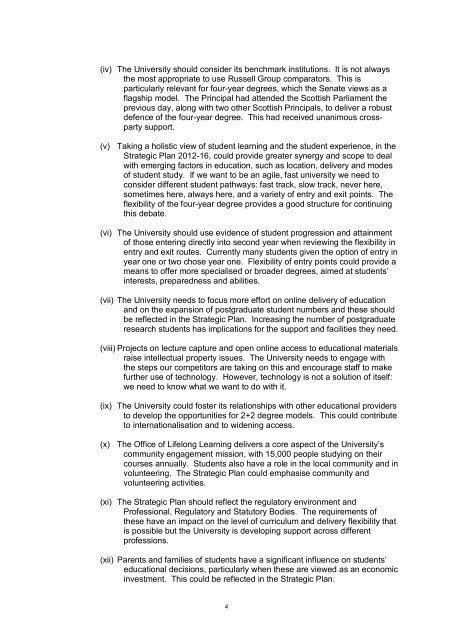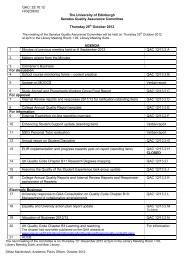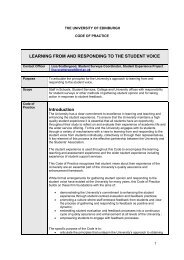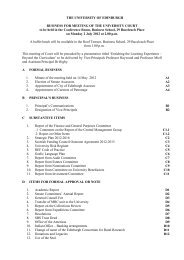H/02/02/02 eSenate: January 2012 The University of Edinburgh ...
H/02/02/02 eSenate: January 2012 The University of Edinburgh ...
H/02/02/02 eSenate: January 2012 The University of Edinburgh ...
- No tags were found...
Create successful ePaper yourself
Turn your PDF publications into a flip-book with our unique Google optimized e-Paper software.
(iv) <strong>The</strong> <strong>University</strong> should consider its benchmark institutions. It is not always<br />
the most appropriate to use Russell Group comparators. This is<br />
particularly relevant for fouryear degrees, which the Senate views as a<br />
flagship model. <strong>The</strong> Principal had attended the Scottish Parliament the<br />
previous day, along with two other Scottish Principals, to deliver a robust<br />
defence <strong>of</strong> the fouryear degree. This had received unanimous crossparty<br />
support.<br />
(v) Taking a holistic view <strong>of</strong> student learning and the student experience, in the<br />
Strategic Plan <strong>2012</strong>16, could provide greater synergy and scope to deal<br />
with emerging factors in education, such as location, delivery and modes<br />
<strong>of</strong> student study. If we want to be an agile, fast university we need to<br />
consider different student pathways: fast track, slow track, never here,<br />
sometimes here, always here, and a variety <strong>of</strong> entry and exit points. <strong>The</strong><br />
flexibility <strong>of</strong> the fouryear degree provides a good structure for continuing<br />
this debate.<br />
(vi) <strong>The</strong> <strong>University</strong> should use evidence <strong>of</strong> student progression and attainment<br />
<strong>of</strong> those entering directly into second year when reviewing the flexibility in<br />
entry and exit routes. Currently many students given the option <strong>of</strong> entry in<br />
year one or two chose year one. Flexibility <strong>of</strong> entry points could provide a<br />
means to <strong>of</strong>fer more specialised or broader degrees, aimed at students’<br />
interests, preparedness and abilities.<br />
(vii) <strong>The</strong> <strong>University</strong> needs to focus more effort on online delivery <strong>of</strong> education<br />
and on the expansion <strong>of</strong> postgraduate student numbers and these should<br />
be reflected in the Strategic Plan. Increasing the number <strong>of</strong> postgraduate<br />
research students has implications for the support and facilities they need.<br />
(viii) Projects on lecture capture and open online access to educational materials<br />
raise intellectual property issues. <strong>The</strong> <strong>University</strong> needs to engage with<br />
the steps our competitors are taking on this and encourage staff to make<br />
further use <strong>of</strong> technology. However, technology is not a solution <strong>of</strong> itself:<br />
we need to know what we want to do with it.<br />
(ix) <strong>The</strong> <strong>University</strong> could foster its relationships with other educational providers<br />
to develop the opportunities for 2+2 degree models. This could contribute<br />
to internationalisation and to widening access.<br />
(x) <strong>The</strong> Office <strong>of</strong> Lifelong Learning delivers a core aspect <strong>of</strong> the <strong>University</strong>’s<br />
community engagement mission, with 15,000 people studying on their<br />
courses annually. Students also have a role in the local community and in<br />
volunteering. <strong>The</strong> Strategic Plan could emphasise community and<br />
volunteering activities.<br />
(xi) <strong>The</strong> Strategic Plan should reflect the regulatory environment and<br />
Pr<strong>of</strong>essional, Regulatory and Statutory Bodies. <strong>The</strong> requirements <strong>of</strong><br />
these have an impact on the level <strong>of</strong> curriculum and delivery flexibility that<br />
is possible but the <strong>University</strong> is developing support across different<br />
pr<strong>of</strong>essions.<br />
(xii) Parents and families <strong>of</strong> students have a significant influence on students’<br />
educational decisions, particularly when these are viewed as an economic<br />
investment. This could be reflected in the Strategic Plan.<br />
4






